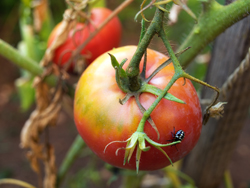Making feeding easier for a parasitic nematode
The relationship between parasite and host is closely woven and many evolutionary adaptations are evident as a means to ensure the survival of both of the members of the partnership. Biochemical links between root knot and cyst nematodes and their hosts, the tomato and potato promote their co-existence. One classic example is that the nematode recruits plant proteins to degrade the cell walls and create modified structures within the plant for its very own feeding area. Scientists working for the project NONEMA aimed to turn the tables against the nematodes and harness these proteins as the basis of resistance to the parasite. They chose the expansins to investigate, a group of genes encoding proteins that reduce the enormous tensile strength of the cellulose cell wall. By loosening the links between the cellulose microfibrils, the cell wall yields to an increased pressure from within the cell. The overall result is that giant feeding cells are produced by repeated nuclear division without cell cleavage. The strong relationship between the host and the parasite is demonstrated by the properties of the expansin gene. Immunolocalisation techniques using polyclonal antibodies verified the link between expansins and the feeding site. The physical presence of the nematode was found to activate two of the identified expansin genes which it then hijacks to create the feeding area that is equipped with its own vascular tissue. Further comprehensive details on the NONEMA project can be found at the website http://nonema.uni-kiel.de/(opens in new window) Information on resistance to nematodes relevant for all interested parties can be accessed. This includes nematode life history on video, publications, biotechnology and related links. Developing resistance mechanisms is preferable to soil sterilisation with the attendant cost and damage to the environment. Data from this research can also be used to form the basis to improve genetic resistance of the many other crops affected by nematodes.



